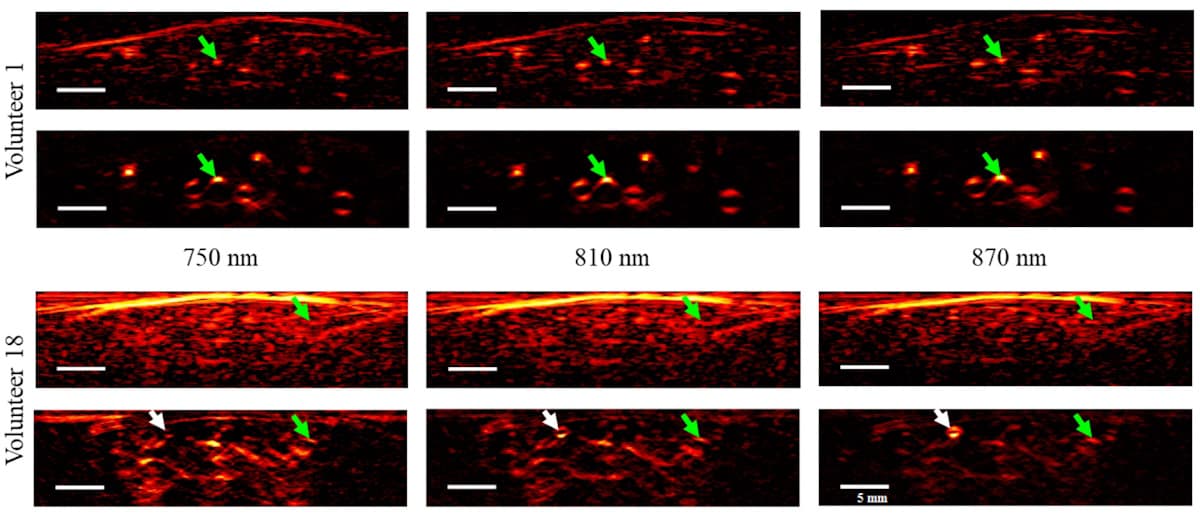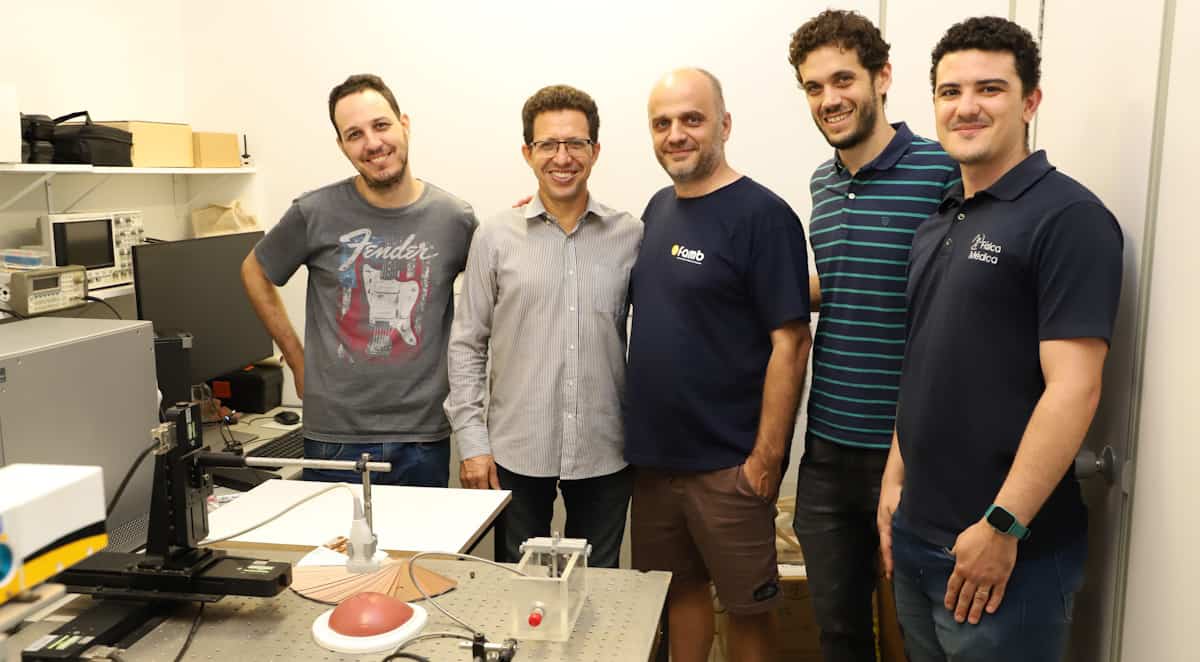
Photoacoustic (PA) imaging is a non-invasive diagnostic technique that can visualize anatomic structures – such as arteries and blood vessels – up to several centimetres deep into tissue. But while this imaging modality works well for people with lighter skin tones, it cannot create as clear images from patients with darker skin.
PA imaging works by illuminating tissue with near-infrared light. The tissue absorbs the optical energy, causing it to expand and generate acoustic waves, which can be detected by conventional ultrasound transducers. When imaging darker skin, however, the increased melanin absorbs more of the incident light, reducing the illumination efficiency. This absorption also generates PA waves at the skin surface, creating image artefacts known as acoustic clutter.
A research collaboration between Johns Hopkins University and the University of São Paulo has found a way to address this problem, using a method called short-lag spatial coherence (SLSC) beamforming, which effectively removes the unwanted clutter signals. The team demonstrated that the SLSC beamforming algorithm significantly increased image quality in all participants – and worked particularly well in those with darker skin tones – reporting their findings in Photoacoustics.

“When you’re imaging through skin with light, it’s kind of like the elephant in the room that there are important biases and challenges for people with darker skin compared to those with lighter skin tones,” says co-senior author and SLSC inventor Muyinatu Bell in a press statement. “Our work demonstrates that equitable imaging technology is possible.”
To test this approach, the team recorded PA data from the forearms of 18 volunteers with differing skin tones, using 750, 810 and 870 nm excitation. To determine the effect of melanin content on conventional amplitude-based PA images, as well as the impact of SLSC beamforming, they calculated the signal-to-noise ratio (SNR) of the radial artery running through the forearm and the level of surrounding clutter artefacts for both conventional and SLSC PA images.
Rather than classifying skin tone with the commonly used, but subjective, Fitzpatrick skin type scale, the researchers used a quantitative method. By measuring the individual typology angle, which correlates with epidermal melanin content, they classified each participant’s skin tone as very light, light, intermediate, tan, brown or dark.
In conventional amplitude-based PA images acquired at 810 nm, the image of volunteer 1 (who had the lightest skin tone) provided good visualization of the radial artery and surrounding small blood vessels. The PA image of volunteer 18, who had the darkest skin tone, contained strong clutter artefacts that compromised radial artery visualization.
Examining the skin PA signal level as a function of skin tone for each volunteer showed that the amplitude of this signal increased with increasing epidermal melanin content. The skin PA signal was also dependent on the optical illumination wavelength, with lower signals observed at higher wavelength.
Conventional PA images of volunteer 1 had minimal acoustic clutter at all three wavelengths. For volunteer 18, however, strong clutter artefacts were seen in the images, particularly at 750 nm, where the radial artery could not be distinguished from the background.
The SLSC PA images, on the other hand, contained far less clutter artefacts, for both light and darker skinned volunteers. For light skin tones, SLSC PA imaging reduced the median clutter level by 0.7 dB, from −16.2 dB with amplitude-based PA imaging to −17.0 dB. The effect was more pronounced for dark skin tones, reducing clutter by 6.1 dB, from −7.9 to −14.0 dB.

This reduced level of clutter led to better visualization of the radial artery. In addition, SLSC PA images from volunteer 18 revealed a small blood vessel that was previously masked by clutter in the conventional PA images.
Calculating SNR values for the radial artery (for the three wavelengths combined) showed that for all volunteers, the SNR decreased for darker skin tones in the conventional PA images. SLSC beamforming improved this SNR by a median of 3.8 dB across all skin tones, enhancing radial artery visualization. The team notes that the SLSC SNR achieved with the darkest skin tone was comparable to the conventional SNR for the lightest skin tone.
The researchers conclude that the quantifiable bias introduced by skin tone variations was successfully mitigated with SLSC beamforming. They are now working to apply these findings to breast cancer imaging, to image the blood vessels that accumulate in and around tumours.

Skin tone impacts photoacoustic measurements of blood oxygenation
“We’re aiming to mitigate, and ideally eliminate, bias in imaging technologies by considering a wider diversity of people, whether it’s darker skin tones, higher breast densities or greater body mass indexes – these are currently outliers for standard imaging techniques,” says Bell, who recently received a Science Diversity Leadership Award for her research into inclusive imaging technologies. “Our goal is to maximize the capabilities of our imaging systems for a wider range of our patient population.”
“To the best of our knowledge, our study represents the first quantitative analysis of the relationships between skin tone, clutter level and image quality in photoacoustic imaging,” co-senior author Theo Pavan tells Physics World. “Our findings suggest that it would be beneficial for future clinical studies utilizing photoacoustic imaging to incorporate participant skin tone information in their research.”
- SEO Powered Content & PR Distribution. Get Amplified Today.
- PlatoData.Network Vertical Generative Ai. Empower Yourself. Access Here.
- PlatoAiStream. Web3 Intelligence. Knowledge Amplified. Access Here.
- PlatoESG. Carbon, CleanTech, Energy, Environment, Solar, Waste Management. Access Here.
- PlatoHealth. Biotech and Clinical Trials Intelligence. Access Here.
- Source: https://physicsworld.com/a/high-quality-diagnostic-imaging-for-all-skin-tones/
- :has
- :is
- :not
- :where
- ][p
- $UP
- 1
- 10
- 2023
- 237
- 7
- 750
- 8
- 9
- a
- absorbs
- Accumulate
- achieved
- acquired
- across
- addition
- address
- Aiming
- AL
- algorithm
- All
- also
- analysis
- and
- Apply
- approach
- ARE
- around
- AS
- At
- author
- background
- BE
- Bell
- beneficial
- BEST
- Better
- between
- bias
- biases
- blood
- body
- both
- Bottom
- brown
- but
- by
- calculated
- called
- CAN
- Cancer
- cannot
- capabilities
- causing
- challenges
- classified
- clear
- click
- Clinical
- collaboration
- combined
- commonly
- comparable
- compared
- Compromised
- conclude
- considering
- contained
- content
- conventional
- could
- create
- Creating
- Currently
- Dark
- darker
- data
- decreased
- deep
- demonstrated
- demonstrates
- dependent
- detected
- Determine
- diagnostic
- Diagnostic imaging
- differing
- Distinguished
- Diversity
- each
- effect
- effectively
- efficiency
- elephant
- eliminate
- energy
- enhanced
- enhancing
- equitable
- Expand
- far
- Fernandes
- findings
- First
- Fitzpatrick
- For
- found
- from
- function
- future
- generate
- generates
- goal
- good
- greater
- Green
- had
- hand
- her
- high-quality
- higher
- hopkins
- However
- HTTPS
- ideally
- illuminating
- image
- images
- Imaging
- Impact
- Impacts
- important
- improved
- in
- incident
- Inclusive
- incorporate
- increased
- increasing
- indexes
- indicate
- individual
- information
- into
- introduced
- issue
- IT
- johns
- Johns Hopkins University
- jpg
- Kind
- knowledge
- known
- Leadership
- Led
- left
- less
- Level
- light
- lighter
- like
- location
- lower
- Mass
- max-width
- Maximize
- measurements
- measuring
- method
- minimal
- Mitigate
- more
- Notes
- now
- of
- on
- open
- or
- Other
- our
- participant
- participants
- particularly
- patient
- patients
- People
- Physics
- Physics World
- plato
- Plato Data Intelligence
- PlatoData
- population
- possible
- press
- previously
- Problem
- pronounced
- provided
- quality
- quantitative
- range
- ratio
- received
- recently
- recorded
- Reduced
- reducing
- Relationships
- Reporting
- represents
- research
- researchers
- Revealed
- right
- Room
- running
- s
- sao
- says
- Scale
- seen
- several
- show
- showed
- Signal
- signals
- significantly
- Skin
- small
- smaller
- Spatial
- standard
- Statement
- strong
- structures
- studies
- Study
- Successfully
- such
- suggest
- Surface
- Surrounding
- Systems
- team
- technique
- techniques
- Technologies
- Technology
- tells
- test
- than
- that
- The
- their
- There.
- These
- they
- this
- those
- three
- Through
- thumbnail
- to
- TONE
- top
- true
- type
- university
- unwanted
- used
- using
- Utilizing
- Values
- very
- Vessel
- visualization
- visualize
- volunteer
- volunteers
- was
- waves
- Way..
- WELL
- were
- when
- whether
- which
- while
- white
- WHO
- wider
- with
- Work
- worked
- working
- works
- world
- would
- zephyrnet













